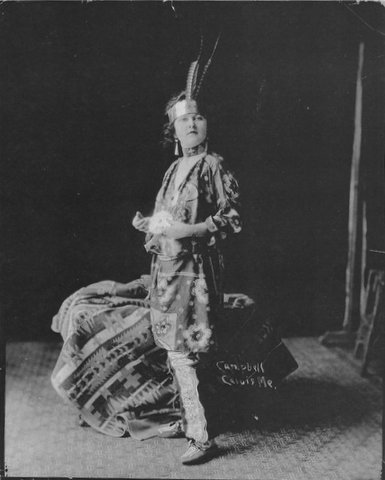
Mrs. Campbell of Calais above is modeling a rare and beautiful wedding costume worn in the 1760s when the daughter of a Passamaquoddy chief married a French nobleman named John Lacoote. The photo was taken in 1923 when the Bangor Daily wrote an article describing this rather unusual marriage between a Passamaquoddy chief’s daughter and a French nobleman.
The Bangor Daily News, 1923:
ROMANCE OF OLD INDIAN COSTUME
Interesting Story Dates Back 160 Years
Valuable Historical Belle CALAIS, Feb. 27, 1923 Bangor Daily News
Around the quaint old Indian costume worn by Mrs. N. V. Campbell of this city, wife of the well known artist photographer Mr. N. V. CAMPBELL, is woven one of the most unusual Indian romances of the early times, of 160 years ago. The story is related by W. Wallace Brown, who 52 years ago was Indian agent in Calais and a great friend and confidant of the Indians who told him many interesting stories of their customs and experiences.
This story concerns one John LaCoote, a French nobleman, who was engaged to marry a member of the French nobility in France, who jilted him, and in order to forget his unhappy love affair, he departed for Montreal with four servants and took up a government grant of 160 acres of land which is embodied in one of the principal streets of Montreal of today. He later visited friends at St. Andrews, N. B., several miles from Calais, and which at that early period was the headquarters of the Passamaquoddy Tribe of Indians.
The chief had an only daughter named Negua-Nesquos-suck, meaning in English, Red Rose, which tradition says was not very pretty in face, but of wonderful form. LaCoote fell in love with her and was accepted and her father made great preparations for a wedding. He invited 100 persons from each of the four different tribes, the Mohawks from New York, Micmacs of Nova Scotia, Penobscots of Old Town and the of Nelcites from St. John river.
Four hundred guests arrived for the great event. They were married first by the visiting priest in the log house at St. Andrews, and then they went to the Indian settlement In the same town, and were again man led by the Indian custom. All the residents of the town were invited to the wedding and there was a large crowd in attendance. The wedding festivities lasted four weeks and the fun was kept up day and night. All the refreshments were furnished by LaCoote, who joined the Indian tribe and was made a chief. They afterwards moved to Pleasant Point, near Eastport, Maine.
While on a visit to Calais, LaCoote who lived to 102 years of age, was taken sick and died and was buried at Pleasant Point.
The Indian bride’s costume, here shown, consists of a silk tunic, buckskin beaded moccasins, leggings of red broadcloth embroidered with colored beads. A peaked beaded cap, fancy woven beaded garters, a girdle made from white wampum and garnets and jewelry from raw silver, consisting of two mus kemaka or breast plates. A bracelet and earrings of rare workmanship and a fancy head band and a priceless necklace of Indian wampum, the equal of which would be hard to find in the world today. It is said by those who have seen it that it is a much better specimen of rare Indian wampum than the one now on exhibition at the museum in Washington, D.C. Mr. W. Wallace Brown, owner of the costume and wampum, is the oldest active wealthy businessman in Calais, and also has other rare Indian antiques, given him by the Indians years ago.
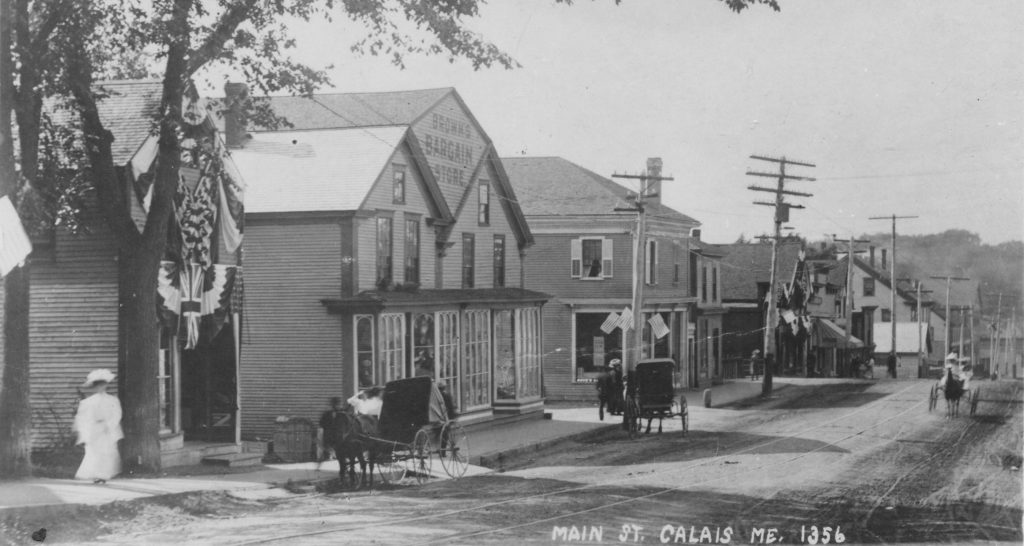
The article is not entirely accurate. The costume was actually part of the collection of tribal artifacts owned by Mrs. Wallace Brown, a nationally recognized expert on native American languages and history, especially that of the Passamaquoddy. She and her husband operated Brown’s Bargain Store on Main Street. While he was officially the “Indian Agent” for many years she was the expert on the tribe, its customs and language and is the most likely source for the article. She may well have been the last to wear the wedding costume at a tribal event.
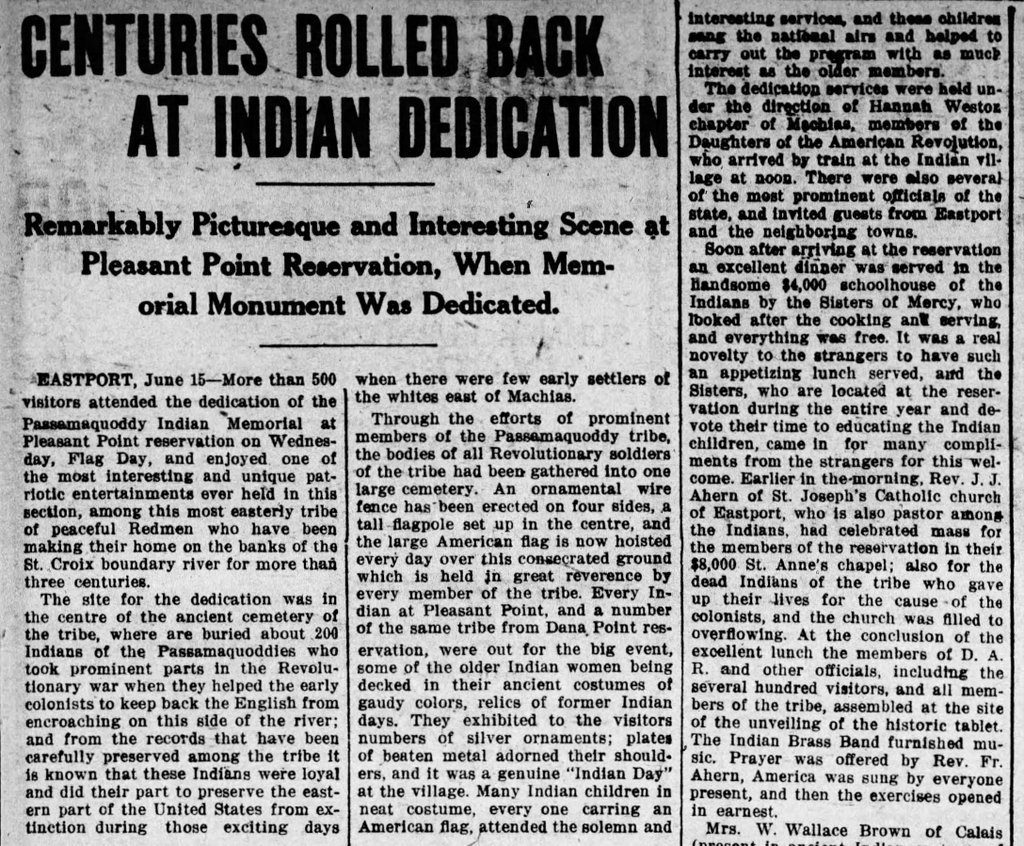
According to the Bangor Daily of June 16, 1916:
Mrs. W. Wallace Brown of Calais (present in ancient Indian costume of many fancy colors) had prepared an interesting paper entitled. The Wabanki Part in the Revolutionary War, and Indian Characteristics, which was read, and which was heard with deep interest. The article of Mrs. Brown contained several legends of the tribe and was well received.
According to Donald Soctomah, tribal historian:
I have a photo of Mrs. Wallace Brown wearing the regalia at the dedication of the Revolutionary Monument. It was originally worn when Chief Neptune’s daughter married the French nobleman Lacoote in the mid 1700s. She is wearing two medallions with designs on them, before the metal disks were used it was seashells, maybe sand dollars, or scallop shells. The glass beads she is wearing were formerly porcupine needles. That would be a great find.
We don’t know what became of the wedding costume and as Donald suggests it would “be a great find” if it could be located.
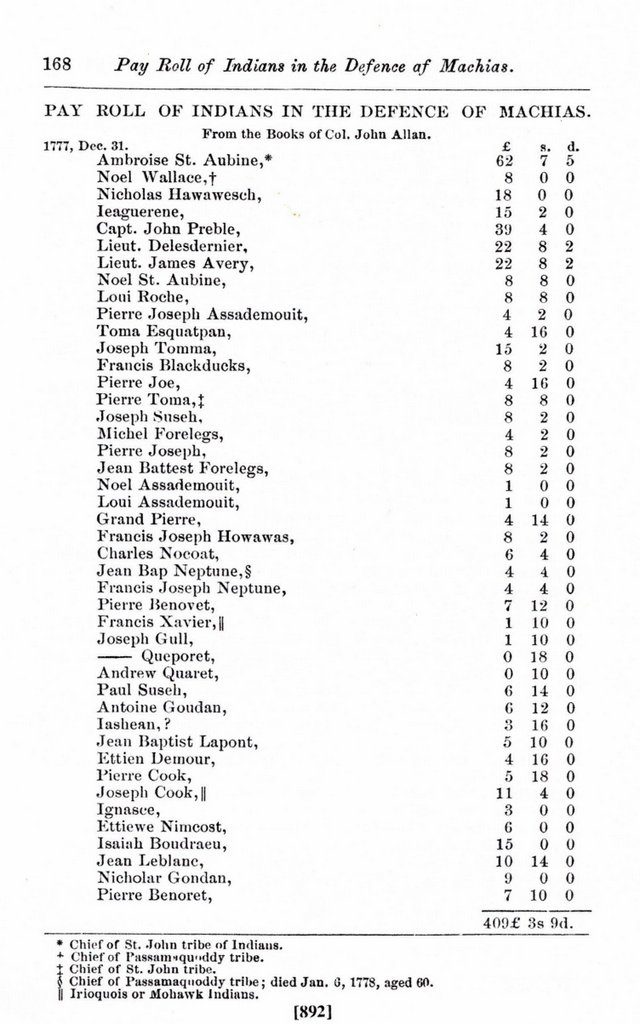
When the memorial was dedicated in 1916 it was long overdue. The role of the Passamaquoddy Tribe in the Revolution has been largely overlooked by historians but it was critical Downeast. Colonel John Allen who commanded all American forces in this area and was a particular favorite of George Washington said this about the role of the Passamaquoddy and Penobscot Tribes during the Revolution:
“Had it not been for the Indians the boundary line would run along the Penobscot River instead of the St. Croix”.
He went on to describe the tribe’s heroic conduct at the Battle of Machias:
“I employed the Indians, between 40 and 50 of them, after I had spoken to them upon the matter. They very cheerfully went on duty down the river and attacked the enemy on open ground, not more than 100 yards from the cannon’s mouth and exposed to the enemy’s fire, but with undaunted courage they vigorously attacked the enemy in such an effectual manner that they fled in consternation and many of them were unable to get back to their boats when ordered and several of the crews of the boats were killed or wounded. The brig kept up all this time a constant and heavy fire of grapeshot and lagrange, but not withstanding that our people were exposed by Divine Providence only one man was killed.”
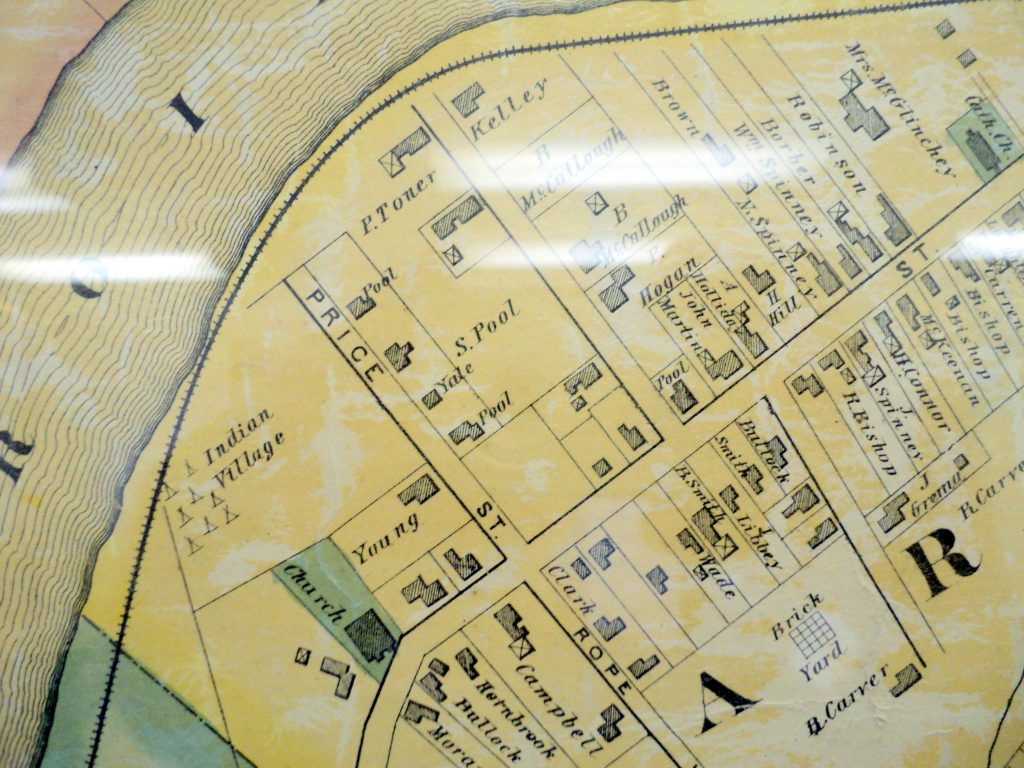
We’ll end with some Calais tribal history which we are sure will be a surprise to many. Calais was home to a Passamaquoddy village for well over a hundred years. It was at the end of Price Street and abutted the railroad tracks. The church shown on the map was associated with the village we believe and as late as the 1940s tribal members lived in the village. Louis Morrison, who was born in the early 1920s and lived on Price Street, told us in an interview years ago that he was friendly as a boy with a number of the village residents. Folks who lived in the Union called the area “Indian Hill”. We do wish we knew more about this settlement.
